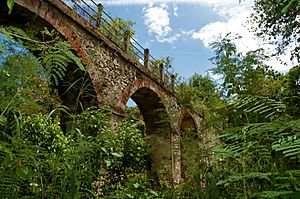Acueducto de Ponce facts for kids
Quick facts for kids
Acueducto de Ponce
|
|
|---|---|

El Murallón de La Cantera portion of the Acueducto Alfonso XII
|
|
| Begins | Río Portugués, San Patricio, Ponce, Puerto Rico 18°01′15″N 66°36′50″W / 18.02085°N 66.61380°W |
| Ends | Cerro San Tomás Barrio Sexto, Ponce, Puerto Rico 18°01′15″N 66°36′50″W / 18.02085°N 66.61380°W |
| Official name | Acueducto Alfonso XII |
| Maintained by | Municipality of Ponce, Puerto Rico |
| Characteristics | |
| Total length | 4,100 m (2.5 mi), 4,100 m (4,500 yd) |
| Width | 0.52 m (1 ft 8 in) (interior conduit channel only) |
| Height | 50 ft (15 m) at highest |
| Capacity | 40.51 L/s (1.431 cu ft/s) |
| History | |
| Construction start | 21 August 1876 |
| Construction cost | $220,000 ($6.05 million in 2022 dollars |
| Opened | 1880 |
| Closed | 1928 |
|
Acueducto de Ponce
|
|
| NRHP reference No. | 100004854 |
| Added to NRHP | December 30, 2019 |
| References | |
| Reference List | |
The Acueducto de Ponce, also known as Acueducto Alfonso XII, was a historic water system in Ponce, Puerto Rico. It was about 2.5 miles (4 kilometers) long. This system used gravity to bring water to the city.
It was designed in 1875 by Timoteo Luberza. This aqueduct was the first modern water system built in Puerto Rico. It was declared a National Historic Monument in 2015.
Contents
Where Was the Aqueduct Located?
The most famous part of the aqueduct was its reservoir. This reservoir was located on the Cerro San Tomás hill. This hill is near the Mameyes area, in the La Cantera neighborhood of Ponce.
History of the Aqueduct
Building the aqueduct was a big project. People like Eustaquio Quesada and Salvador Coronas supported it. They even promoted it in the local newspaper, El Fénix.
Construction started on August 21, 1876. It cost about $220,000, which was a lot of money back then! The aqueduct started working in 1880. It was used for 48 years, until 1928.
A generous donation helped build it. Valentín Tricoche gave 54,000 Spanish pesos. He also left money in his will to build Hospital Tricoche.
How the Water System Worked
The Acueducto de Ponce got its water from the Río Portugués river. This river's valley covered about 30 square kilometers. The river starts near the Ponce-Jayuya and Ponce-Adjuntas roads.
In 1915, there were some houses and farms near where the aqueduct took in water. Because of this, people were a bit worried about the water getting dirty.
What the Aqueduct Looked Like
The aqueduct was about 4,100 meters (or 4,442 yards) long. It used gravity to move water. It was first 3,000 meters long from the dam to the reservoir. Later, it was made longer to 4,100 meters.
The aqueduct was eventually closed down in 1928. This happened when a new water system, which used pumps, was opened. At its highest point, the aqueduct stood 50 feet tall.
The Intake Dam
The dam that collected water for the aqueduct was on the Río Portugués river. It was about 1 kilometer north of where the Rio Chiquito river joins it.
The dam was a low wall made of stone. It didn't store much water. There was a small pool in front of the dam. This pool was deep enough to protect the intake. It also had a screen to stop leaves and other things from getting in.
The Water Channel
Water traveled from the dam to the reservoir through a channel. This channel was made of brick. It was about 0.52 meters (20 inches) wide and 0.55 meters (22 inches) deep. The top of the channel was shaped like a half-circle.
The channel ran through areas with bushes and young trees. It also passed through pastures and old cattle yards. Closer to the reservoir, it went along a very steep hill. It also passed through the Mameyes area of the La Cantera neighborhood.
The Reservoir
The reservoir was made of brick and lined with cement. It was covered to keep the water clean. It could hold 2,000 cubic meters of water.
The reservoir was split into two parts. At the time, the government thought it held enough water for one day for Ponce's 35,000 residents.
Water Distribution in the City
The main water pipe went into the city of Ponce along Calle Atocha. It crossed many streets like Calle Guadalupe, Calle Victoria, Calle Vives, Calle Sol, Calle Isabel, Calle Cristina, and Calle Comercio.
There was a system to deliver water block by block. This covered about 80 city blocks. Water was available everywhere around Plaza Las Delicias (the main town square) and for at least four blocks outwards.
What Happened to It?
As new and better water systems were built, the aqueduct was stopped in 1928. It was then left alone and fell into ruins for many years.
However, in 2015, a senator named Víctor Vasallo Anadón worked to save the aqueduct. He proposed a law to make it a historic structure. This would help get money to preserve it. On June 9, 2015, it was voted a National Historic Monument. It was officially listed on the U.S. National Register of Historic Places on December 30, 2019.
See also
 In Spanish: Acueducto Alfonso XII para niños
In Spanish: Acueducto Alfonso XII para niños
- Barrio Mameyes
- Old Piedras River Aqueduct: An aqueduct in San Juan, Puerto Rico
- National Register of Historic Places listings in Ponce, Puerto Rico

